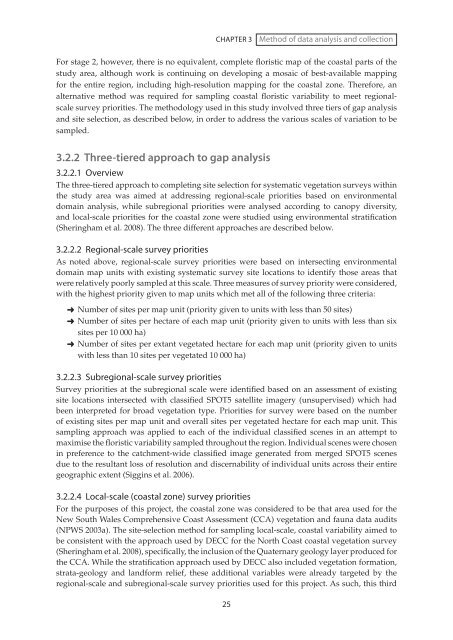Free Download - HCCREMS
Free Download - HCCREMS
Free Download - HCCREMS
Create successful ePaper yourself
Turn your PDF publications into a flip-book with our unique Google optimized e-Paper software.
CHaPTeR 3 Method of data analysis and collection<br />
For stage 2, however, there is no equivalent, complete floristic map of the coastal parts of the<br />
study area, although work is continuing on developing a mosaic of best-available mapping<br />
for the entire region, including high-resolution mapping for the coastal zone. Therefore, an<br />
alternative method was required for sampling coastal floristic variability to meet regionalscale<br />
survey priorities. The methodology used in this study involved three tiers of gap analysis<br />
and site selection, as described below, in order to address the various scales of variation to be<br />
sampled.<br />
3.2.2 Three-tiered approach to gap analysis<br />
3.2.2.1 Overview<br />
The three-tiered approach to completing site selection for systematic vegetation surveys within<br />
the study area was aimed at addressing regional-scale priorities based on environmental<br />
domain analysis, while subregional priorities were analysed according to canopy diversity,<br />
and local-scale priorities for the coastal zone were studied using environmental stratification<br />
(Sheringham et al. 2008). The three different approaches are described below.<br />
3.2.2.2 Regional-scale survey priorities<br />
As noted above, regional-scale survey priorities were based on intersecting environmental<br />
domain map units with existing systematic survey site locations to identify those areas that<br />
were relatively poorly sampled at this scale. Three measures of survey priority were considered,<br />
with the highest priority given to map units which met all of the following three criteria:<br />
➜ Number of sites per map unit (priority given to units with less than 50 sites)<br />
➜ Number of sites per hectare of each map unit (priority given to units with less than six<br />
sites per 10 000 ha)<br />
➜ Number of sites per extant vegetated hectare for each map unit (priority given to units<br />
with less than 10 sites per vegetated 10 000 ha)<br />
3.2.2.3 Subregional-scale survey priorities<br />
Survey priorities at the subregional scale were identified based on an assessment of existing<br />
site locations intersected with classified SPOT5 satellite imagery (unsupervised) which had<br />
been interpreted for broad vegetation type. Priorities for survey were based on the number<br />
of existing sites per map unit and overall sites per vegetated hectare for each map unit. This<br />
sampling approach was applied to each of the individual classified scenes in an attempt to<br />
maximise the floristic variability sampled throughout the region. Individual scenes were chosen<br />
in preference to the catchment-wide classified image generated from merged SPOT5 scenes<br />
due to the resultant loss of resolution and discernability of individual units across their entire<br />
geographic extent (Siggins et al. 2006).<br />
3.2.2.4 Local-scale (coastal zone) survey priorities<br />
For the purposes of this project, the coastal zone was considered to be that area used for the<br />
New South Wales Comprehensive Coast Assessment (CCA) vegetation and fauna data audits<br />
(NPWS 2003a). The site-selection method for sampling local-scale, coastal variability aimed to<br />
be consistent with the approach used by DECC for the North Coast coastal vegetation survey<br />
(Sheringham et al. 2008), specifically, the inclusion of the Quaternary geology layer produced for<br />
the CCA. While the stratification approach used by DECC also included vegetation formation,<br />
strata-geology and landform relief, these additional variables were already targeted by the<br />
regional-scale and subregional-scale survey priorities used for this project. As such, this third<br />
25


